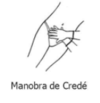O PARTO Flashcards
(42 cards)
TIPOS DE BACIA

DEFINIÇÃO DE ATITUDE FETAL
Relação das partes entre si.
DEFINIÇÃO DE SITUAÇÃO F.
Relação entre MAIOR EIXO FETAL x MAIOR EIXO UTERINO.

(Logitudinal (95%) / Transversal (1%) / Oblíqua)
DEFINIÇÃO DE POSIÇÃO FETAL
Relação do dorso fetal c/ abd materno.
(Esquerda/Direito)
- Logitudinal: D/E
- Transversal: Ant./Post.

DEFINIÇÃO DE APRESENTAÇÃO FETAL
Relação polo fetal e o estreito sup. da pelve.
- Logitudinal: Cefalico/Pelvico
- Tranversal: Cormico (Ponto R: Acromio)

PONTO DE REFERENCIA DA APRESENTAÇÃO CEFALICA FLETIDA


PONTO DE REFERENCIA NA DEFLEXÃO 1º GRAU


PONTO DE REFERENCIA NA DEFLEXÃO 2º GRAU

GLABELA

PONTO DE REFERENCIA NA DEFLEXÃO 3º GRAU

MENTO.

PONTO DE REFERENCIA NA APRESENTAÇÃO PÉLVICA

SACRO

TIPO DE PELVE TEM MELHOR Px P/ PARTO VAGINAL

Ginecoide.
TIPO DE APRESENTAÇÃO TEM PIOR Px P / PARTO VAGINAL

Deflexão de 2 grau.

PLANO DE DeLee


PONTO DE REFERENCIA MATERNA

Apresentação fetal mais frequente no periodo expulsivo

OP - Occipitopúbico (Lambda virado p/ pubis)

MANOBRA DE LEOPOLD-ZWEIFEL

1 TEMPO: Deprimir funfo uterino (Apresentação)
2 TEMPO: Deslizar as mãos p/ polo inf. do utero. (Posição)
3 TEMPO: Sente o Polo fetal, ao estreito sup. da bacia e sua mobilidade.
- Movel: NÃO encaixado.
- Fixo: Encaixado.
4 TEMPO: Frente p/ os pés, faz pressão na direção da emtrada pelvica. (Altura da apresentação)

PASSOS DO MECANISMO DE PARTO
- INSINUAÇÃO
- DESCIDA
- ROTAÇÃO INTERNA
- DESPRENDIMENTO CEFALICO
- ROTAÇÃO EXTERNA
- DESPRENDIMENTO CORMICO OVOIDE
*REVER NO RESUMO
ROTAÇÃO INTERNA


CONTRAÇÃO DE Braxton Hicks

Contrações incordenada, frequentes, focais, baixa intensidade, NÃO triplice gradiente descendente.

TEMPO DE DILATAÇÃO

- PRIMIPARA: 10-12h
- MULTIPARA: 6-8h
Diltação cervical total

10cm.
CONTRAÇÃO

2-4contraç./10min (40mmhg) c/ duração 50s
VELOCIDADE da dilatação na F. ATIVA
- PRIMIPARA: 1cm/h
- MULTIPARA: 1,5cm/h
CONDUTA NA F. DE DILATAÇÃO

- Dieta (Liq. claros)
- Acesso IV
- Decubito lat. (NÃO DORSAL - retorno venoso)
- BCF (↓Risco: c/ 30m / ↑Risco: c/ 15min)
- Banheira c/ água morna.




















